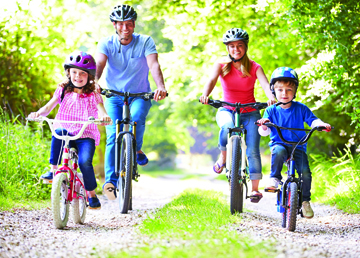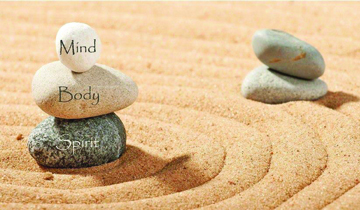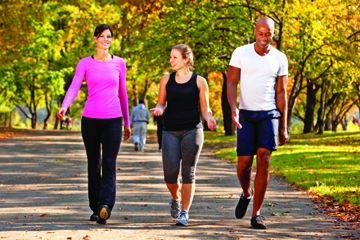
by Glendale Sports Center | Jun 21, 2019 | Feature Story Middle Left
by Parker Grissom
School is out and summer is here! The warm weather makes us
all want to get outside, and when we do it’s important to stay safe. These tips
can help!
Stay Hydrated
We can’t say it enough: The rule of summer is to hydrate.
But it’s not always the best bet to aim for eight 8-ounce glasses a day.
Runner’s World reports that recommended amounts are actually 91 ounces a day
for women and 120 ounces for men. That said, people vary in their activity levels
and “sweat rates,” so it is pretty safe to let thirst be your guide.
The following are other important things to know about
hydrating.
Sometimes water isn’t enough. Water is necessary for every
metabolic process of the body, as it transports nutrients and removes waste.
However, if you go for a long run or are out in the heat all day, you may need
a drink with enhanced electrolytes that can prevent your body from losing
sodium.
Water won’t keep you cool. Speaking of heat, it’s also
important to recognize that hydration alone cannot ward off the risk of heat
stroke. While dehydration can make you more prone to it, factors like exercise
intensity, humidity and air temperature can all contribute.
Don’t drink too much. Finally, while it is rare, it is possible
to drink too much, which can result in a condition called hyponatremia. When
this happens, the increased fluid intake combines with increased sweating,
causing sodium levels in the blood to become dangerously low. To prevent this,
again it’s best to let thirst be your guide and don’t overdo it.
Get The Right Gear
As you set out for Colorado’s playground, another tip to
keep in mind is equipment and clothing. In addition to outfitting yourself for
your favorite outdoor pastime, whether it is hiking, biking, running, or
camping, you also have to factor in the season’s challenges surrounding
altitude, wildlife and quick weather changes.
The best bet here is to get quality advice you trust. Do
your research and talk to others who know the ropes. This is especially
important when it comes to evaluating “trends” in fitness such as barefoot
running. Some experts say that exercising without shoes makes it possible to
absorb negative electrons from the earth through the soles of the feet, which
can be an antioxidant and have an anti-inflammatory impact on the body. It also
can improve foot position, balance and body awareness.
At the same time, other experts caution that barefoot
walking and exercising can come with increased risk. Lack of strength in the
foot can reveal poor walking mechanics, which can lead to injury. Barefoot
exercisers are also susceptible to injury from rough or wet terrain, cold
temperatures and sharp objects on the ground.
Bottom line: It’s important to seek wise advice and use your
best judgment. Know what’s a trend in fitness and what makes sense for your
lifestyle.
Remember The Sunscreen
A final way to stay safe — and another reason to use your
best judgment — is in regard to sunscreen. Recent reports have made us
second-guess ourselves and wonder whether all the sun protection could be doing
more harm than good. Harvard Medical School addresses some common
misperceptions: Does sunscreen cause skin cancer? (It doesn’t!) Does sunscreen
prevent the three main types of skin cancer? (It does!). And is sunscreen
actually poisonous to people? (It isn’t!)
The reality is that Colorado has more than 300 days of
sunshine a year, and reports show risk of skin cancer goes up with altitude, so
sunscreen is essential. Harvard Medical School also recommends avoiding sun
exposure when possible, wearing sun-protective clothing, and reapplying
sunscreen every two hours.
Parker’s purpose on earth is to make every person he meets
happier and healthier. With a degree in Exercise Science from University of
North Carolina at Wilmington, Parker achieves this purpose through group
fitness, personal training, and motivational speaking.

by Glendale Sports Center | May 25, 2019 | Feature Story Middle Left
by Nicholas Auger
Cycling is by far one of the best non-impact exercises
around, and some of the most important aspects of cycling are in the details.
Understanding them can help you turn biking from a childhood hobby into a key
element of a healthy and active lifestyle. Here are four tips to get you
started down the road.
ABC Bicycle Check
Before you get on any bicycle, run over the basic components
of the bike and confirm they are working. The “ABC Check” is a universal
approach.
A is for Air. Check that both wheels are inflated to a firm
squeeze. If they’re low, check the side of the tire for the inflation number
labeled as PSI, which will typically be 45 to 65 and can go up to 160.
B is for Brakes. Inspect the braking mechanism. It could be
a hand lever on the handle bars or a coaster brake. Engage the brakes and try
to move to see if the tires roll. They should not!
Lastly, C is for Chain. Pedal the cranks backward (or
forward if you have coaster brakes) and check that the chain is intact and
moves easily.
Manage Comfort
Make sure you’re comfortable on the bike! Bicycles have
specific sizes and can be modified to fit many different riders. When you are
on the bicycle, the seat should be high enough for your leg to almost fully
extend. And typically, if on the saddle, you should be on your tippy toes to
reach the ground. This will help you use your leg muscles in a more efficient
way.
Adjust the handlebars, grips, and levers. A bicycle mechanic
can help you make additional modifications. Cycling shorts with pads and
thicker seats, as well as gloves and glasses, can provide quick improvements.
Lastly, safety: Invest in a helmet that is less than eight years old and make
sure it is comfortable.
Balance Your Body/Mind Connection
When you start a cycling routine, it’s common to overdo it
at first, or to get quickly discouraged after a few hills. Cycling calls for
strength to power major muscle groups, and cardiovascular endurance — both can
leave you out of breath when you’re first starting out. This is where
understanding the importance of breathing and a few breathing exercises can
improve your performance before you get on the bike.
The first is Alternative Nostril Breathing or Anuloma
Viloma. As a yoga movement, the exercise is designed to calm and stabilize your
mind and body and balance the right and left side of the brain, which makes
pedaling more even.
To do the exercise, take these steps:
• Begin in a
comfortable, seated position in a chair or the floor with pillows.
• With one
hand, make the “hang loose” sign with your pinky and thumb extended.
• Take in a
full inhale through your nose.
• Using your
thumb on the “hang loose” hand, close your right nostril and fully exhale out
of your left nostril.
• Once the
exhale is complete, keep your thumb in the same place and take a full inhale
through your left nostril.
• Once the
inhale is complete, use your pinky on that same hand to close the left nostril,
keeping your thumb closing the right nostril. Hold your breath in with both
nostrils closed.
• On the next
inhale, remove your thumb and exhale fully out of the right nostril.
• Now inhale
fully with your pinky closing the left side nostril.
Another exercise is known as the One-Minute Breath. Also
performed off the bike, the exercise involves taking the least amount of
breaths you can for one minute. First, sit comfortably and slow your breathing,
focusing on all parts of the breath. Progressively lengthen the timing of each
inhale and exhale, pausing and retaining your breath every time you breathe in
and out.
Ride To The Rhythm …
Of Your Breath
Once on the bike, practicing breath cadence can keep you
going the distance. To do this, count your breaths to the rhythm of your crank
revolutions. For example, one inhale may last as long as four crank
revolutions. Focusing on the pace of your breathing and your physical exertion
syncs your breathing with your body, which helps regulate oxygen flow, control
your heart rate, and boost your endurance.
Through cycling, you can improve strength and your overall
health and push your fitness to new levels. Besides it’s just plain fun. Pedal
on!
Nicholas found fitness through his BFA in sculpture. Now,
instead of metal and wood, he focuses on enriching communities through creating
programs that sculpt spirit, mind and body. Ten years of teaching yoga, kids
yoga, group exercise, and personal fitness training has led him to the role of
Health and Wellness Director at the Downtown Denver YMCA.

by Mark Smiley | Apr 29, 2019 | Feature Story Middle Left
by Cate Plekon
May is Women’s Health Month and it’s the perfect time for
women to explore new, powerful ways to live healthy and feel their best. Here
are four ways to celebrate this month and integrate a well-rounded approach to
your health and wellness routine.
Start getting regular check-ups. Whether you’re new to
exercise, making a comeback after a hiatus, or you’re a seasoned expert, it is
important to check in with your doctor to discuss your physical activity. At
the age of 34, I only recently discovered that women should be getting annual
physicals just like men! This means paying a visit to your internal medicine
practitioner, not just your OB/GYN. Take this opportunity to discuss your diet
and current fitness routine. Ask for advice on where you should ease up or what
more you might incorporate.
Try something new. People often get into a rut with their
exercise routines, which can cause fitness goals to stall. To prevent this,
it’s a good idea to mix things up. Perhaps you can run a marathon, but you’ve
never tried a stretching class to increase flexibility and help muscles
recover. Maybe cardio isn’t your favorite, but you do like to dance. In this
case, try dance workouts such as Zumba and Nia. Adding something new can
reenergize your workouts, and it can prevent overuse injuries, break through
weight-loss plateaus and build new muscles.
Lift weights — properly. Because of increased risk of
osteoporosis, women specifically are advised to incorporate weight lifting into
their exercise routines. This disease involves a loss of bone density, and it
affects approximately half of women over the age of 50. Osteopenia is the
midway point between having healthy bones and having osteoporosis, and it can
actually be reversed through proper nutrition and regular weight lifting.
A personal trainer is a qualified expert who can guide you
through a new or existing weight lifting program and help you get the most from
your strength training. What makes a personal trainer better than a video or
fitness app is that the trainer can see you. This means they can keep a close
eye on your technique and alignment to maximize your moves and help prevent
injury.
Remember nutrition and mental health. Finally, it’s easy to
think health and wellness is based solely on being active. But there are other
components to consider as well, and that includes what we eat and how we feel.
For example, at a recent doctor’s appointment, I was advised
to start incorporating more fats and protein into my morning meals. I often
reach for fruit or cereal to get me going in the morning, but I’m learning
that’s just not enough to carry me through my workouts. Because of my busy
lifestyle, I can’t afford the time to make (and clean up) a whole meal with
eggs and bacon. One quick conversation with a nutritionist later, and I’m now
equipped with several easy, high-protein make-in-advance breakfast recipes.
We need to also recognize that total wellness includes our
mental well-being. Physical exercise, along with meditation and prayer, can
improve mental health. Sometimes, however, more specialized methods might be
necessary. Take an honest look at how you’re thinking and feeling and take
steps to clear and recharge your spirit and mind.
Cate is the fitness coordinator at the Littleton Family
YMCA. She has worked for the Y for more than 10 years and in various
capacities, including group fitness and personal training. She joined the
Denver YMCA in 2017 after moving to the area from Memphis, TN.

by Mark Smiley | Apr 1, 2019 | Feature Story Middle Left
Focus On Your Breathing
by Nicholas Auger
Wellness of the spirit, mind and body of course calls for
balanced nutrition and regular exercise. But there’s one more thing you could
be doing to improve your health. Here’s a hint: You’re doing it right now.
Breathing!
While we can survive without food and water, we cannot live
without regular intake of oxygen — it’s the single most important function of
the body. We may assume breathing is automatic and something we don’t have to
think about. But actually, proper breathing can promote relaxation and
self-awareness and improve your overall health. Here are two points to keep in
mind to make sure you’re taking your best breaths.
Rule #1: Use Your Nose
Take a few minutes and focus on your breathing. When doing
this, note that you should be breathing in and out of your nose. This is
important for several reasons.
When we breathe in through the nose, our nose hairs filter
incoming particles and pollution. Then, when we exhale, the nose expels debris.
This added resistance makes the lungs work harder, increasing oxygen flow.
Through the nose passage we also regulate the temperature of the air we breathe
as it enters our body. The nose warms the air to prevent drying in the lungs
and bronchial tubes.
If you find yourself breathing through your mouth, it could
be because your nose is clogged due to allergies, a sinus infection, or stress
and anxiety. Talk to your doctor, and then make a consistent, conscious effort
to breathe through your nose. Keep in mind that using your mouth regularly for
breathing — instead of your nose — can result in periodontal disease, throat
and ear infections and halitosis (bad breath.)
The exception to this best practice? During strenuous
exercise, you should focus on breathing in quickly and deeply through your nose
and then exhaling through your mouth.
Rule #2: Take Complete Breaths
Another thing to note about breathing is that breaths should
be slow, deep and complete.
This is important because deep breathing increases
cardiovascular capacity and the amount of oxygen that gets sent to our cells.
Deep breathing expels toxins from the lungs that have been picked up through
the circulatory process. And, as you breathe deeply, the diaphragm moves and
massages and stimulates the organs. Moreover, taking complete breaths promotes
relaxation, reduces stress and increases mental clarity.
For breaths to be complete, every inhale should fill your
lungs and every exhale should empty your lungs. Doing this engages your entire
torso. Start with your low torso, breathing in as your belly expands. Continue
taking in the breath slowly until your ribs expand and your chest and shoulders
lift.
Practice taking 10 complete nose breaths feeling the breath
work up through your torso. This is considered essential breath meditation, and
it can do wonders in improving wellbeing of the spirit, mind and body.
About Nicholas Auger: Nicholas found fitness through his BFA
in sculpture. Now, instead of metal and wood, he focuses on enriching
communities through creating programs that sculpt spirit, mind and body. Ten
years of teaching yoga, kids Yoga, group exercise, and personal fitness
training has led him to the role of Health and Wellness Director at the
Downtown Denver YMCA.

by Mark Smiley | Feb 25, 2019 | Feature Story Middle Left
by Cami Martin
Everyone knows good nutrition is important. But with so much information out there, it’s easy to feel overwhelmed and think that eating right is too complicated or just plain unappetizing. In celebration of National Nutrition Month in March, we’re sharing five easy, delicious strategies you can implement right away to boost your diet and improve wellness without disrupting your lifestyle or the things you enjoy.
Add fruits and vegetables. So many times, people skip fruits and vegetables because they feel too much pressure to get those “eight servings” a day. Whew! While that amount is optimal, it’s important to remember that every portion counts, and even in small amounts, fruits and vegetables boost health with vitamins, minerals and fiber. Try to add just one fruit or vegetable to every meal.
Reduce added sugars. Fruit contains natural sugar, which is good for you. But what you want to be aware of are added sugars found in foods and drinks. This is not limited to sweet treats and sodas. Sugar can be found in things you might not think of: ketchup, soy sauce, marinades, yogurts, and more. Check nutrition labels and keep track. The American Heart Association recommends limiting sugar to 37.5 grams a day for men and 25 grams a day for women.
Slow down at mealtime. A lot of times we eat the wrong things — or too much of them — because we’re distracted and not paying attention. Eating when we’re upset, rushing, or watching TV can cause us to overeat and/or not appreciate our food. Instead, practice “mindful eating,” which involves using all the senses to explore, savor, and taste, so that we choose food that is pleasing to the palate and nourishing to the body. It works on the premise that the less distracted we are during mealtimes, the better our overall health and well-being.
Try a meatless meal once a week. Perhaps you’ve heard of “Meatless Mondays?” This is a great way to introduce more fruits and vegetables to your life without committing to a strict vegetarian diet. Just once a week — it doesn’t have to be Mondays — substitute a typical meat dinner for a recipe with veggies, beans, lentils or tofu. This gives your digestive system a break from meat or poultry, and it gives you an opportunity to seek out plant-based nutrition, which can help lower blood pressure, lower cholesterol, improve blood sugar, reduce the risk of cancer, and promote weight loss.
Make breakfast count. Despite controversy in recent years about the importance of breakfast, researchers continue to find that what we eat first thing can have profound effects on our health, well-being and cognitive performance. That said, breakfast is only as good for you as what you choose for breakfast. Skip the sugary cereals and donuts. Opt instead for proteins and complex carbs — try a parfait with low-fat plain Greek yogurt and fruit, or a quick egg scramble with sautéed vegetables.
For total wellness, good nutrition is essential. It can be the difference maker when it comes to meeting your fitness goals and feeling your best. And, it can be a lifesaver in promoting good health and preventing diabetes, obesity, and heart disease.
Cami is a nutritionist, DTR (Dietary Technician, Registered), and a Certified Health and Wellness Lifestyle Coach. She is involved in many YMCA programs, including Diabetes Prevention, Healthy Weight and Your Child, and Blood Pressure Self-Monitoring. Her passion is showing others how healthy habits are achievable and one of the greatest ways to feel your best.

by Mark Smiley | Jan 28, 2019 | Feature Story Middle Left
by Ally Myer
A healthy heart is essential for your body to function. It affects your ability to move with ease, feel energized, and wake up alert. Blood carries oxygen, along with nutrients from the food you eat, fueling your muscles and your other organs. Because your heart is so essential, it’s just as important to keep it healthy. Here are four things you can do at home for optimal heart health.
1. Get the heart pumping. Like any other muscle, the heart gets stronger when it is challenged. A great way to challenge your heart at home is by doing stair sprints. Run up and down the stairs for 30 seconds, and then walk around the room for one minute. Repeat sprints at least three times, or more based on your energy and fitness level. Getting out of breath is a good thing!
2. Establish a walking routine. First thing in the morning, during your lunch break, or right before eating dinner, go for a quick 10- to 20-minute walk. This increases blood flow, helping clear the arteries. It also helps increase metabolism and burn fat, which are beneficial for heart health.
3. Meditate. Meditation helps the nervous system relax, allowing the heart to beat slower and giving your whole bodily system a break. Also, when you’re relaxed throughout the day, you’re less likely to overeat and engage in other unhealthy behaviors that can harm your heart. Aim to meditate every day for 10 minutes. You can do it on your own quietly or play calming music. Another way to meditate is to use an online app such as “Calm” meditation and sleep stories.
4. Practice gratitude. Always focusing on the negative can affect your heart health, and the American Heart Association reports there are established ties between depression, mental health and heart disease. It’s also possible to experience a literal “broken heart” in the form of stress-induced cardiomyopathy. But, having a positive mindset through gratitude can have real cardiac benefits. To do this, gratitude exercises can help. List five things you feel you’ve done right in your life and thank yourself for those decisions. Next, list five things you love about someone special and thank them for those things. Finally, list five things you are enjoying today and thank the universe or God for them.
Incorporating just two or three of these home heart exercises can make a huge difference in your health and spirit. For greater benefit, we recommend adding strength training, aerobic exercise, balance, and coordination practice at least three times per week.
Ally Myer is the Health and Wellness Coordinator at the Southwest Family YMCA. As a personal trainer and group fitness instructor also, Ally helps people improve their fitness and eating routines to achieve optimal functioning. She has a degree in Health Sciences from Clemson University and has been working in the fitness industry for six years.







